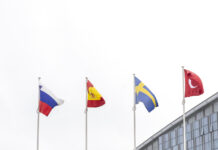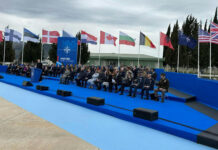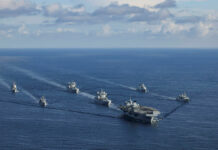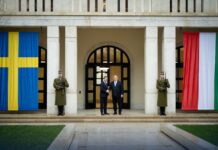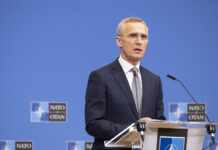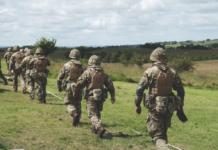There was a time, and it was not that long ago, that even the suggestion that Finland would join NATO would be greeted with total disbelief.
It was just totally inconceivable. Yet in the 1980s, if you had insisted that the fall of the Soviet Union was inevitable and would likely happen soon, your views would have been dismissed without a thought. As we shall see, in recent years unexpected things have been happening in the European security environment far too often for comfort. Many ignored the danger signs, while other grew increasingly concerned until eventually they had to act.
This brings us to our starting point which took place of 5 July 2022 at NATO headquarters in Brussels, Belgium, when NATO ambassadors signed the Accession Protocols for Finland and Sweden in the presence of Finnish Foreign Minister Pekka Haavisto and Swedish Foreign Minister Ann Linde. This followed on from the Madrid Summit held in Madrid from 28-30 June, attended by the leaders of NATO Member governments where it was agreed to invite Finland and Sweden to join the NATO alliance. The signature of the Accession Protocols is the first stage of the ratification process for NATO membership which still has some months to run before the two nations become active NATO members, assuming that no obstacles arise.
NATO’s Strategic Concept
What motivated Finland and Sweden to suddenly take the plunge and look for NATO membership? That becomes quite clear when you consider NATO’s new 2022 Strategic Concept, adopted at the Madrid Summit, that states: ”The Russian Federation is the most significant and direct threat to Allies’ security and to peace and stability in the Euro-Atlantic area. It seeks to establish spheres of influence and direct control through coercion, subversion, aggression and annexation. It uses conventional, cyber and hybrid means against us and our partners. Its coercive military posture, rhetoric and proven willingness to use force to pursue its political goals undermine the rules-based international order. The Russian Federation is modernising its nuclear forces and expanding its novel and disruptive dual-capable delivery systems, while employing coercive nuclear signalling. It aims to destabilise countries to our East and South. In the High North, its capability to disrupt Allied reinforcements and freedom of navigation across the North Atlantic is a strategic challenge to the Alliance. Moscow’s military build-up, including in the Baltic, Black and Mediterranean Sea regions, along with its military integration with Belarus, challenge our security and interests.”
A Challenge to the Alliance
The 2022 Strategic Concept continued: ”NATO does not seek confrontation and poses no threat to the Russian Federation. We will continue to respond to Russian threats and hostile actions in a united and responsible way. We will significantly strengthen deterrence and defence for all Allies, enhance our resilience against Russian coercion and support our partners to counter malign interference and aggression. In light of its hostile policies and actions, we cannot consider the Russian Federation to be our partner. However, we remain willing to keep open channels of communication with Moscow to manage and mitigate risks, prevent escalation and increase transparency. We seek stability and predictability in the Euro-Atlantic area and between NATO and the Russian Federation. Any change in our relationship depends on the Russian Federation halting its aggressive behaviour and fully complying with international law.”
Without fear of contradiction, it was plain that both Finland and Sweden sought “stability and predictability” in their strategic area of interest as part of the post-Cold War/post-Soviet security environment in Europe. This has become harder and harder to achieve in the face of Russian actions in recent years. As with the majority of European nations, Finland and Sweden had believed that Europe had achieved a relatively benign security environment in comparison with the Cold War era. However, the warning signs were already there that all was not what it seemed with this benign environment.
Warning Signs
The first major warning sign came in August 2008 with the Russian invasion of Georgia in support of the Russian-backed separatist republics of Abkhazia and South Ossetia, with the invasion being described as a “peace enforcement operation” by Russia. Sweden was quite clear in condemning the Russian action but others were much less forceful, feeling that Georgia was not in Europe and therefore not a European security issue. Indeed, in 2009 the EU sponsored an independent report led by a Swiss diplomat that seemed to make strenuous efforts to avoid attaching any blame to Russia for the Georgia invasion!
For NATO members in the Baltic States and Eastern Europe, as well as Sweden and Finland, it was increasingly clear that Russia was no longer content to be passive and was starting to actively move towards challenging the post-Cold war strategic settlement in Europe. Others were far more forgiving of Russian intentions and for more interested in economic relations with Russia.
When Russia annexed Crimea in 2014 and started the war in the Donbas, the US and European response was much weaker than when it invaded Ukraine in February 2022. Although the Obama administration did provide some aid to Ukraine, they seemed unwilling or unable to consider the fate of Ukraine as a core US security interest. The tepid response of the US in 2014 provided the cover for a limited European response and, in the main, it was business as usual with Russia. Dependence on Russian oil, gas and raw materials was already a major consideration.
The Past as the Future
Both Helsinki and Stockholm were being forced to re-evaluate the strategic threats that they faced and the available means that they had to confront those threats. It was plain that Russia had a new agenda as regards the Baltic and Eastern Europe. As far back as 2005, Vladimir Putin had described the fall of the Soviet Union in 1991 as the “greatest geopolitical catastrophe” of the twentieth century. The agenda that Putin had was not based on nostalgia for the Soviet Union; its ideological underpinning is Russian nationalism and the desire to see Russia regain the former Soviet position of being a dominant power.
Russian nationalist ideology calls for a return to the borders of the former Soviet Union, meaning that, at a minimum, Ukraine and the Baltic States would need to become Russian client states or, preferably for Russia, absorbed entirely. There is more though talk of Russia returning to its “traditional borders” beyond the Soviet borders and also include the borders of Imperial Russia. This would require the dismemberment of Poland and the end of an independent Finland. Inevitably, Helsinki and Warsaw are extremely concerned by Russian nationalist ideology.
A History of Conflict
At this point, it is necessary to provide a brief historical background to relations between Finland, Sweden and Russia. Sweden and Russia have a history of conflict that dates back to the 12th Century. Both nations sought supremacy in the Baltic region, a struggle that continued through to the Finnish War of 1808/1809. Sweden under the auspices of the Baltic Crusades had come to dominate what we would today recognise as Finland by the end of the 13th Century. However, the price of Sweden losing the Finnish War of 1808/1809 was to cede control of what became known as the Grand Duchy of Finland to Tsarist Russia.
The collapse of Tsarist rule and the revolutions of February and October 1917 created a situation where Finland could declare independence in December 1917, with the Bolshevik regime of V.I. Lenin recognising Finnish independence in January 1918. Three weeks later, the Finnish Civil War broke out which lasted until May 1918 when White forces backed by the German Empire prevail over Red forces who wanted a Socialist Workers Republic and received support from Soviet Russia. Out of the post-war rubble, Finland emerged as a Republic led by an elected president.
At the end of November 1939, the Soviet Union invaded Finland in what came to be known as the Winter War. Finnish resistance was courageous, but when the conflict came to an end in March 1940, Finland had to make major territorial concessions to the Soviet Union. In June 1940, Finland watched as the Soviet Union invaded Estonia, Latvia and Lithuania, eventually incorporating them into the Soviet Union. Feeling that it had few other options and looking to regain its lost territory, Finland embarked on the Continuation War in June 1941.
The Continuation War came to an end with the Moscow Armistice of September 1944. In the post-War settlement of the Paris Peace Treaty of 1947, Finland retained its national independence, but had to make further territorial concessions to the Soviet Union and pay reparations. This was followed by the signature of a treaty of Friendship, Cooperation, and Mutual Assistance with the Soviet Union in 1948. The treaty recognised Finnish independence but forced the country to become a neutral power and have its freedom of action limited by the necessity to retain the goodwill of the Soviet Union, added to which the Soviet Union was Finland’s main trading partner, a situation that became known as “Finlandization.”
German reunification, the end of the Cold War and the collapse of the Soviet Union finally allowed Finland to make its own economic and foreign policy decisions. In 1995, they joined the EU and in 1999 joined the Euro. Main export markets for Finland are Germany, Sweden, the US, the Netherlands and China, with Russia accounting for five percent of Finnish exports. Main sources of imports are Germany, Sweden, Russia (13 per cent of total imports), China and the Netherlands. Although 43 per cent of Finland’s electricity comes from hydropower and renewables, 17 per cent comes from nuclear power and 43 per cent from fossil fuels (oil and gas). Russia was the main supplier of oil and gas, it also supplied electricity via a connector. Russian supplies of oil, gas and electricity have now ended, forcing Finland to purchase oil and gas on international markets and also demonstrating its energy vulnerability.
Defence Capabilities
Finland had always been prepared to invest in its defence capabilities but it had been limited in the defence equipment it could acquire due to the terms of the Paris Peace Treaty. With the collapse of the Soviet Union, the treaty became void and Finland could acquire equipment from the US and other sources. This saw the Finnish Air Force acquire 64 F/A-18C/D aircraft from the US, with deliveries commencing in 1995. The F/A-18C/D fleet is to be replaced under the terms of the HX Fighter Programme. In December 2021, the Lockheed Martin F-35A Joint Strike Fighter (JSF) was selected as the winner of HX and 64 aircraft ordered to be delivered from 2026 onwards.
As others in Europe downsized their militaries, Finland was able to acquire a whole range of advanced ground systems at very advantageous prices. For example, they obtained 100 LEOPARD 2A6NL tanks and 22 M270 MLRS fire units from the Royal Netherlands Army, TOW missiles from Denmark and 147 MT-LB armoured vehicles from Sweden. There were also major purchases from across Europe of new equipment, with Sweden emerging as one of the most important suppliers and later becoming a partner for defence collaboration.
Finland has also sought to further diversify its supplier base. For example, the Finnish Navy purchased the UMKHONTO air defence missile system from South Africa for the Mid-Life Upgrade (MLU) of its HAMINA class missile boats and HÄMEENMAA class minelayers. The HAMINA MLU also saw the IAI GABRIEL V anti-ship missile acquired, with the same weapon being selected for the four POHJANMAA class corvettes that are being built between 2022 and 2025. Finland also acquired SPIKE-MR/-LR and SPIKE-ER missiles from the Eurospike consortium. In 2017, the Finnish Defence Force selected the Hanwha Defense K9 as its future self-propelled artillery system, ordering 48 systems from Republic of Korea Army (ROKA) surplus stocks and then placing a second order for 10 more systems.
Finland had maintained a robust defence capability while many others in Europe had allowed their defence forces to whither. As things have turned out, this defence investment showed a remarkable degree of foresight. That is not to say that they expected the security situation in the Baltic to turn critical, although a resurgent Russia with a nationalist ideology was in itself threatening, but Finland is used to managing its relationship with Russia.
In the end, what turned Finland and Sweden towards NATO membership was a spectacular foreign policy failure by Russia itself. Russian aggression in the Ukraine was decisive, but years of threats and aggressive rhetoric towards the three Baltic states and Finland and Sweden created a situation where the only sound security strategy was joining NATO. It is truly ironic that Vladimir Putin has not only breathed new life into NATO, but has also enlarged it as a result of his actions. L






